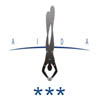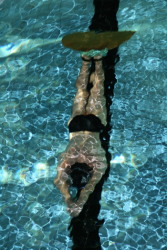|
home
|
APNOEVISION.CH
|
|
|
LAUFEND NEUE KURSE
International Association for the Development of Apnea AIDA ***Freediver Course Outline
To enrol in the AIDA ***Freediver course, an individual must:
•
Be 18 years of age or older (16 years with parent or guardian
consent) COURSE PURPOSE
The AIDA *** is an intermediate course which builds on the skills
learnt in the
To conduct an AIDA ***Freediver course, the following knowledge
development, confined water dives and open water dives are to be
included: KNOWLEDGE DEVELOPMENT
The knowledge development will take place in a classroom-like
environment. The theory sessions will include:
•
Physics –Dalton’s Law, Boyle’s law, Buoyancy applied to deep diving CONFINED WATER DIVES
This part of the course is intended to refresh the student diver’s
existing rescue skills. It also introduces the student freediver to
Static Apnea and Dynamic Apnea training tables and the benefit of
warm-ups as a preparation for a maximum performance. The sessions
should be conducted in a swimming pool or similar Confined Water Session One - Training Tables After this session the student freediver will be able to:
•
Design an appropriate Static Apnea Training Table for themself to
build tolerance
•
Design an appropriate Static Apnea Training Table for themself to
build tolerance
•
Design and perform an appropriate Dynamic Apnea Training Table with
minimum 20
•
Demonstrate the appropriate rescue technique for a buddy
experiencing a loss of Confined Water Session Two - Maximum Performances After this session the student freediver will be able to:
•
Plan and perform a static session warming up to a maximum breath
hold of at
•
Demonstrate a dynamic apnea dive of at least 55m, with attention to
breathe up,
•
Demonstrate an appropriate safety dive for a buddy performing a dive
of at
OPEN WATER DIVE SESSIONS
These dives should be conducted in open water with a fixed line to
be used as a point of reference by the student freediver. This line
should be sufficiently buoyed and weighted so that the student
freediver could use it to pull either up or down if necessary. The
line is recommended to be at least 8mm in diameter. The maximum
depth of the freedives should be limited to not more than 30m,
either by choosing a site of this depth or by placing a bottom plate
on the line at a maximum of 30m. Open Water Dive Session One- Technique and Equalisation Practice After this open water session, the student freediver will be able to: • Demonstrate the ability to operate all the quick releases on the safety lanyard
•
Demonstrate how to adjust weighting for deeper freedives, identify
the point of
•
Perform efficient, effective duck dives, remaining oriented to the
guide line while • Demonstrate appropriate surfacing and recovery breathing after a dive
•
Describe and practice The “Frenzel” equalisation technique Open Water Dive Session Two- Free falling, Self Rescue and Safety diving After this open water session, the student freediver will be able to: • Identify hazards and points of interest for the chosen open water dive site
•
Practice free falling and keep practicing Frenzel equalizing, duck
dives, remaining
•
At least three times, effectively safety dive for a freediver
attempting a constant
•
Demonstrate the self rescue technique for a leg cramp suffered at
depth, Open Water Dive Session Three- Training and Rescue After this open water session, the student freediver will be able to:
•
Practice free falling, Frenzel equalizing, duck dives, remaining
oriented to the • Act as a safety diver for the other freedivers as they do their dives
•
Demonstrate appropriate rescue technique for a freediver who arrives
at the Open Water Dive Session Four- Warm up and Maximum Performance After this open water session, the student freediver will be able to:
•
Warm up for and perform a constant weight dive to a depth of at
least 24m
•
Effectively safety dive for a freediver attempting a constant weight
dive, timing
•
Descend to 10m, remove the mask and ascend with the mask in the hand
to
•
Tow an inert freediver to shore/boat a minimum distance of 50m EQUIPMENT Student Equipment – mask, fins or monofin, snorkel, appropriate exposure protection, weightbelt, lanyard Instructor Equipment – mask, bi-fins, snorkel, appropriate exposure protection, weightbelt, stop watch, depth gauge, lanyard, guideline with bottom plate, floatation device, first aid kit, oxygen administration kit (in countries where this is required or permitted by local law) (If there is a student that is using a monofin during the course, the Instructor can use a monofin when he/she is showing skills and techniques to this student) Optional Equipment –nose clip, goggles, lights, underwater video camera
The AIDA *Freediver course may be conducted by an Active AIDA Instructor with current CPR and First Aid training (completed within the last two years). The instructor should carry liability insurance for teaching freediving.
The maximum student diver-to-instructor ratio for open water
training dives is four students per instructor (4:1). This may rise
to six students per instructor (6:1) when the instructor is assisted
by another freediver qualified to at least AIDA **** level. The
maximum student diver-to-instructor ratio in confined water is eight
students per instructor (8:1). With an AIDA ****Freediver acting as
an Assistant, 4 additional students may be added to this ratio to a
maximum of 12 students. ADMINISTRATION AND PAPERWORK Before commencing any in-water training, each student freediver must complete the following documents, for students aged under 18 years, both must be co-signed by a parent or guardian:
•
AIDA Medical Statement – this must be completed in full with
students marking • AIDA Liability Release or local equivalent
The AIDA Instructor should hold these documents on file for a
minimum of seven years or longer if required by local legislation. CERTIFICATION PROCEDURES Freedivers who meet all the performance requirements outlined above may be certified as an AIDA ***Freediver.
Freedivers who meet all the performance requirements other than
those listed under Open Water Dives may be certified as AIDA ***Pool
Freediver. KEY STANDARDS
Prerequisite certifications: AIDA **Freediver
AIDA Freediver Kurse
AIDA Spezial Kurse
|
||



 AIDA *Freediver
AIDA *Freediver AIDA **Freediver
AIDA **Freediver AIDA ****Freediver
AIDA ****Freediver


 AIDA Competiton
Freediver
AIDA Competiton
Freediver

.jpg) Entspannungs-/
Mentaltraining
Entspannungs-/
Mentaltraining